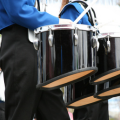Note: I initially wrote this in Japanese in Aug 2021 and thoughtfully translated it into English to share its insights with a broader audience.
The album “Anti-Crime Breaks: Thrilling and Badass Jazz Funk Tracks,” the first general release under the MER (Model Electronic Records) name, features robust and thrilling jazz funk and breakbeat tracks that will surely get your adrenaline pumping. This article provides a detailed explanation or commentary about this album.
Background 1: Experiencing the 70s US Crime Actions Films and Where I Come From
The music used in crime action movies is conventionally called “crime music” or “crime jazz.” Still, I’m naturally opposed to crime and violence. So, I deliberately (and with a touch of humor) added “Anti-” at the beginning to emphasize this point.
Are you familiar with crime action films set in 1970s New York, such as “Shaft,” “Super Fly,” “Across 110th Street,” “The French Connection,” and “The Taking of Pelham One Two Three”? I first encountered these films over 30 years ago as a Tokyo student. Looking back, it seems naive, but at the time, I simply enjoyed them as entertainment, thinking, “I’ve found some really cool movies and music!”
Moving to the United States, in the very places where these films were shot, has significantly deepened my understanding of them.
Specifically, while there are unrealistic or exaggerated elements as they are entertainment, I can now recognize many ‘plausible’ scenes and foreshadowings in the stories and visuals, which added depth and complexity to the narratives. These are based on the history of conflicts between the mafia and police and the bitter difficulties of racism. Even in today’s society, I can imagine similar incidents and stories occurring. Even though it’s fiction, it’s somewhat grounded in a harsh reality.
On the other hand, when I revisit Japanese detective TV dramas like Daitokai (『大都会』) or Seibu Keisatsu (『西部警察』), the experience is vastly different. I find myself profoundly appreciating the craftsmanship that goes into these programs and their coolness as fiction/crime action dramas. Above all, I am really entertained with joy. While they may lack the raw, chilling reality you would feel from their American counterparts, their professionalism in production is still something to be respected.
Background 2: The Inherent Power and Virtue of “Fiction”
While there’s always criticism of excessive violence in Hollywood films, in America, what’s depicted in movies could happen in reality tomorrow and vice versa. News programs dealing with real-world issues often repeatedly broadcast gruesome crime footage during dinner time, making you think, “Do they really need to show this much?” What surprises me is the literacy (or immunity) towards violence that has been formed in the audience through this long-standing media environment and reality. There seems to be an almost resigned recognition that “the fictional world depicted in movies is brutal, but the reality before our eyes is equally violent and crime-ridden.” This premise, akin to the “original sin” in the Old Testament and the society based on such pessimism and despair, is difficult for the Japanese, raised in a Confucian-influenced culture of inherent human goodness, to fully comprehend.
Since the abolition of the self-regulatory expression code called the Hays Code in 1968, American entertainment has moved towards more truthful expressions and the pursuit of reality. That being said, as creators, it’s also our crucial responsibility to foster emotional investment in fictional worlds and heroes, to stimulate the imagination through music, and to help people forget harsh realities through overwhelming visual beauty or sometimes far-fetched story developments. Even in movies dealing with crime, I advocate for entertainment that crafts ‘high-quality, benevolent lies’ that instill hope and optimism in us living in the real world and for music to be a medium that conveys this more effectively.
I created this work with the desire to be involved in creation while believing in such “virtue of fiction.”
About the Music and Production
Regarding the production aspect, as mentioned earlier, the musical inspiration comes from soundtracks of crime action, spy, and detective dramas from the late 1970s, often seen in Western countries and Japan. Instead of simply recreating or following these in a retro style, however, I wanted to utilize various musical styles and techniques I’ve developed throughout my career to create something fresh and exciting for modern listeners.
“Anti-Crime Tracks” is my first album centered around breakbeats and big beat styles since Captain Funk’s “Bustin’ Loose” (1998) and “Dancing in the Street” (1999). However, compared to those 90s productions, I believe the tracks on this album have a more robust jazz-funk flavor and are more refined in production. My first album, “Encounter with…” (1998), included jazz-leaning tracks, but those had a more atmospheric approach. In any sense, with my knowledge and skills back then, I wouldn’t have been able to create songs like these current ones even if I had wanted to.
Among the ten tracks on the album, a few hold a special place in my heart. My favorite is “Emergency,” introduced in the preview. I also have a soft spot for “The Fugitive” (M1) and “Justice City” (M5). Both are based on breakbeats but incorporate jazz 4/4 beats and walking bass lines midway, creating a dynamic structure.
The production style vastly differs from the late ’90s when I used AKAI samplers, sequencers, and hard disk recorders. It’s a desktop-based production using DAWs like Studio One, Pro Tools, and software instruments. Of course, I never used a sample from commercial records (I haven’t done so in 20 years), and everything you hear in this release is hand-played and programmed. The skills I honed in expressing orchestral sounds through programming in the Dark Model project also helped me express big band sounds this time. While the production process is much more complex and the number of tracks used is enormous compared to the past, the hardware setup has become even more minimal. Aside from instruments like guitars and keyboards, it’s only an ultra-compact Intel NUC PC and a display. How I work on the production looks almost the same as when posting this blog (laughs).
About the Artwork
Initially, I considered using a photo of a 70s-style Caucasian detective for the artwork (though even using the term “Caucasian” may sound problematic now). However, I hesitated because I thought it would repeat the typical subcultural approach often seen in the 1990s.
While I was searching for a better way to convey the exciting and thrilling feeling of this work’s sound, the art director proposed the comic book style that was ultimately adopted. It has the dynamism of an action movie, and the concept of the work is immediately apparent. I also like the impactful panel layout, which adds a storytelling atmosphere to this album.



